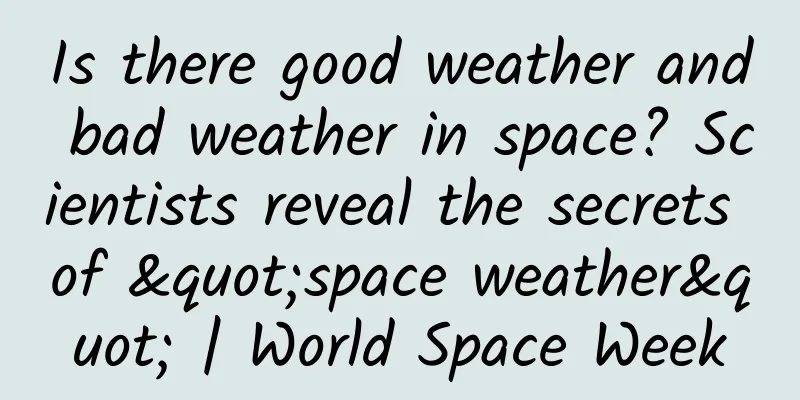Is there good weather and bad weather in space? Scientists reveal the secrets of "space weather" | World Space Week

|
World Space Week is held from October 4 to 10 every year. The theme of World Space Week 2024 is “Space Science and Climate Change”. We are currently facing unprecedented climate challenges, and space science is gradually becoming the key to understanding and solving these challenges. From solar activity to the interaction of the Earth's atmosphere, the connection between space and climate change is becoming increasingly prominent. On the occasion of World Space Week 2024, Science Popularization China invited Researcher Le Guiming from the National Space Weather Monitoring and Early Warning Center to reveal the impact of space science, especially space weather, on us and the Earth. Q: What is space weather and is it the same as our everyday weather? A: In a broad sense , space weather is the physical state of the entire solar system. Since humans live on Earth and most satellites are in the space around the Earth, people are most concerned about the physical state of the space around the Earth; in a narrow sense, the physical state of the space around the Earth is space weather . Space weather mainly includes the distribution and changes of the space magnetic field and the intensity of charged particles in space. This will lead to a series of adverse effects on space-based and ground-based technical systems, such as the safety of the power grid, shortwave communications, the life of underground pipelines such as oil pipelines, navigation and positioning (thus affecting routes flying over high latitudes), electronic equipment on satellites, the health of airline passengers and astronauts, and the orbital height of low-orbit satellites. Space weather is different from everyday weather. Space weather is mainly caused by the movement of plasma, while space weather is caused by the movement of the neutral atmosphere. However, there are good weather and bad weather. Q: What factors affect space weather? Answer : The main factor affecting space weather is solar activity, and other factors include seasons. Q: What are common space weather events ? Answer : Magnetospheric high-energy proton enhancement event, magnetospheric high-energy electron enhancement event, geomagnetic storm, sudden ionospheric disturbance, ionospheric storm, thermospheric storm. Q: For weather, its cycle is 3 65 days, so what about space weather, how long is its cycle? A : Space weather is controlled by solar activity. Therefore, the cycle of solar activity is the cycle of space weather, which ranges from 9 to 14 years, that is, some solar activity cycles are shorter and some are longer. Through statistical analysis, it is found that the length of the solar activity cycle is mostly around 10.6 years, close to 11 years. From a longer time scale, there are cycles of nearly 22 years, 100 years, and even longer cycles. Q: Just now you mentioned that space weather, like daily weather, can be good or bad. So what kind of space weather is extreme space weather? What are the main types of extreme space weather events? How much impact does extreme space weather have on human activities? Answer : Extreme space weather events refer to events that have a very large impact on space-based and ground-based technical systems and occur very infrequently. When the frequency of an event is less than or close to 1‰, such as in solar flares above C level, if the ratio of flares above X5 level is close to 1‰, it can be called an extreme event. For magnetic storm events, the international community uniformly calls magnetic storms with Dst less than or equal to -250 nT super magnetic storms. Solar proton events with a peak flux >10^4 (number of particles/square centimeter × second × solid angle) are called super solar proton events. Solar proton events with relativistic energy are also extreme space weather events. The ratio of the daily integral of electrons with energy above 2MeV in geostationary orbit exceeding 2x10^9 (cm^2·sr·d)^-1 is less than 7‰, which is also an extreme event... Extreme space weather events are very harmful. An extreme event may destroy one or more satellites, causing them to fail permanently, or significantly reduce the function of satellites (such as the solar eruption on July 14, 2000, which caused a satellite to fail permanently and the functions of multiple satellites to be significantly reduced). It may also destroy a power grid or several power grids (such as the solar eruption on March 10, 1989, which destroyed the power grid in Quebec, Canada, causing a major power outage in Quebec, Canada, and the solar eruption on October 28, 2003 caused a major power outage in Malmö, Sweden, and potential threats to multiple power grids in my country). It may cause shortwave communications to be interrupted for several hours (the solar eruption on October 28, 2003 caused a 5-hour interruption of shortwave communications in Manzhouli)... If the extreme event is very severe, it is likely to destroy multiple satellites and multiple power grids... Q: You mentioned earlier that space weather is mainly controlled by solar activity. So when does extreme space weather usually occur in the solar activity cycle? Answer : Among them, more than 65% occur in the declining phase of the solar activity cycle, and more than 80% occur in the two years before and three years after the peak of sunspot activity. In addition, extreme space weather formed by interaction with the magnetosphere mainly occurs near the vernal and autumnal equinoxes. X5-class flares from 1976 to 2018 Super magnetic storms during the period 1932-2018. The red solid dots represent that the super magnetic storms were caused by coronal mass ejection events in the northern hemisphere of the Sun, and the blue solid dots represent that the super magnetic storms were caused by coronal mass ejection events in the southern hemisphere of the Sun. Number of extremely large magnetic storms per month from 1932 to 2018 The daily integral of electrons with energy greater than 2 MeV exceeding 109 d^−1 cm^−2 sr^−1 in different months during 1987-2019 Q: Have people discovered anything about the relationship between solar activity described by long-term sunspot numbers and extreme space weather events? Answer : Statistical studies have found that the stronger the solar activity cycle described by the sunspot number, the greater the number of extreme events overall, but the correlation coefficient between the maximum intensity of an extreme solar activity event and the intensity of the solar activity cycle described by the sunspot number is very low, that is, a weak solar activity cycle may have more severe space weather events than a strong solar activity cycle. Correlation between the amplitude of the solar cycle and the number of extremely large magnetic storms in the solar cycle Correlation between the amplitude of the solar cycle and the strongest magnetic storm within the solar cycle Question: In the face of extreme space weather events, what measures should be taken to minimize the harm caused by extreme space weather events? A : In principle, all spacecraft can be sufficiently hardened against radiation (at a significantly higher cost) to ensure that they can operate normally even in extremely harsh environments. To be economical and efficient, only certain orbits can be over-hardened against radiation. Generally speaking, for spacecraft, in severe space weather conditions, electronic equipment that is vulnerable to attack by charged particles can be considered to be shut down for a period of time. For low-orbit spacecraft, the satellite orbit altitude can be slightly increased. For astronauts, extravehicular operations should be cancelled. For power grids, the current should be lowered (or the power of power grid transformers should be increased sufficiently - significantly increasing the cost). For flights crossing high latitudes, the routes need to be changed or flights need to be cancelled (and then resumed after the extreme event is over). Fishermen should cancel their offshore operations and return home in time... Q: How do scientists currently monitor and predict space weather events ? How far in advance can they make predictions? How accurate are they? A : Space weather monitoring can be divided into ground-based and space-based. Ground-based monitoring networks can monitor solar activity, interplanetary and Earth magnetic fields, ionosphere, and middle and upper atmospheres. Space-based monitoring can monitor the space environment (plasma information, high-energy particle information, magnetic field information, etc.) where the spacecraft is located, can remotely measure solar activity, and also conduct observations close to the sun. Through space-based monitoring, people can achieve full-area monitoring of the middle and upper atmosphere, ionosphere, magnetosphere, interplanetary space, and the sun. Through case analysis of a large number of different events, as well as statistical research and numerical simulation research on a large number of events, people have established many statistical models and numerical models of space weather. People use these models to carry out space weather forecasts. Space weather forecasts are divided into nowcasts about 1 hour in advance, short-term forecasts 1-3 days in advance, medium-term forecasts 27 days in advance, and long-term forecasts three months in advance or even longer. The accuracy of forecasts for sudden solar eruptions (flares and coronal mass ejections) is still relatively low. Relatively speaking, the accuracy of forecasts for magnetic storms is much higher, but it is still very difficult to accurately predict the intensity of magnetic storms. The accuracy of forecasts for ionospheric storms and changes in the density of the middle and upper atmosphere is not high. Q: What are the new trends in space weather research? Answer : Because the level of research depends on the level of observation and the sophistication of the research methods used, the new trend in space weather research is first to strengthen observations, such as multi-angle imaging observations of the sun, strengthening multi-point on-site observations of interplanetary space (non-straight line), strengthening multi-point on-site observations of magnetosphere space and uninterrupted observations of the northern and southern polar auroras (all of which require a lot of funding). In the past, the main research on the physical mechanism and statistical studies of sudden space weather events was carried out. Now, people have begun to introduce methods such as deep learning and machine learning, and combine them with physical mechanism and statistical studies to carry out research on various types of space weather events. Q: The theme of this year's World Space Week is space science and climate change. From your perspective of long-term research in space and weather, what is the relationship between solar activity and the weather and climate on Earth? Answer : Long-term observations have found that during periods when there are many sunspots (years with high solar activity), the plum rain belt moves significantly northward, while during periods when there are fewer sunspots (years with low solar activity), the plum rain belt moves significantly southward. In years with high solar activity, the Huaihe River region has more precipitation and a larger precipitation range; in years with low solar activity, the Huaihe River region has less precipitation and a smaller precipitation range. The amount of ozone in the Earth's atmosphere is generally inversely correlated with the intensity of solar activity, which results in lower temperatures in years with low solar activity and higher temperatures in years with high solar activity. In years with high solar activity, the intensity of cosmic rays decreases, which may lead to fewer clouds and less rainfall, thus contributing to higher temperatures. Conversely, in years with low solar activity, it is conducive to lower temperatures. The main factor affecting climate through solar activity is the intensity of solar radiation. In the long term, the intensity of solar radiation is not a fixed value, but fluctuates slightly. The total solar radiation constant refers to the total energy of solar radiation received per unit area at the upper boundary of the Earth's atmosphere perpendicular to the sun's rays at the average distance between the Sun and the Earth per unit time. Expert support : Le Guiming, researcher at the National Space Weather Monitoring and Early Warning Center Produced by : Science Popularization China x China Meteorological Society x China Astronautics Society |
<<: China not only has the "Black Myth Monkey King", but also the "Millennium Floating Turtle"!
Recommend
Yiche: In November 2024, the sales list of new energy vehicles ranked 60th with cumulative sales of 13,000 vehicles
Last week, the "dissolution of Jiyue Automob...
See how TikTok, Mayu, PUBG, and Jump Jump opened the door to commercialization and monetization?
Where there is traffic , there are advertisements...
Losing weight and developing severe fatty liver? I was so scared that I quickly ate a bite of the cake
Review expert: Wu Xinsheng, deputy chief physicia...
The most comprehensive APP campus channel promotion strategy in history: 15 campus promotion methods, how many do you know?
1. Definition of Campus Channel When developing m...
Kingdee Cloud Developer Conference: Mobile work platform ushered in a year of explosive growth
From January 15th to 16th, the first Kingdee Clou...
What does Android 5.0 look like? See here
[[122241]] Android 5.0 Lollipop is one of the mos...
Increase fans! 6 practical ways to increase followers, I will teach you all of them today!
I have summarized 6 effective ways to increase fo...
What’s the secret behind Microsoft’s proactive deletion of its facial recognition database?
1. Microsoft quietly deleted its facial recogniti...
Apple's smart ring may become a reality. Which is the way out for iRing?
Recently, a patent of Apple named "Device an...
Volkswagen emissions scandal executives plead guilty in US, could face 169 years in prison
According to Reuters, U.S. District Court spokesm...
Getting married really makes you fat! The more affectionate you are, the fatter you get!
Have you ever noticed a phenomenon: people get fa...
How to operate Tiktok with a novice hand, and earn US dollars from 0 to 10,000 followers in 3 days
So today such a course comes out! Course Catalog:...
Trans fats are more terrible than sugar, and they are in the food you often eat! Let’s read the “confession” of trans fatty acids
Author: Bo Chunyan Jiujiang First People's Ho...
Google almost wasn’t the Google it is today
Google co-founders Larry Page and Sergey Brin rece...
App promotion, if you can do these 4 things, you will be an expert!
Recently, people often ask me about promotion. So...









